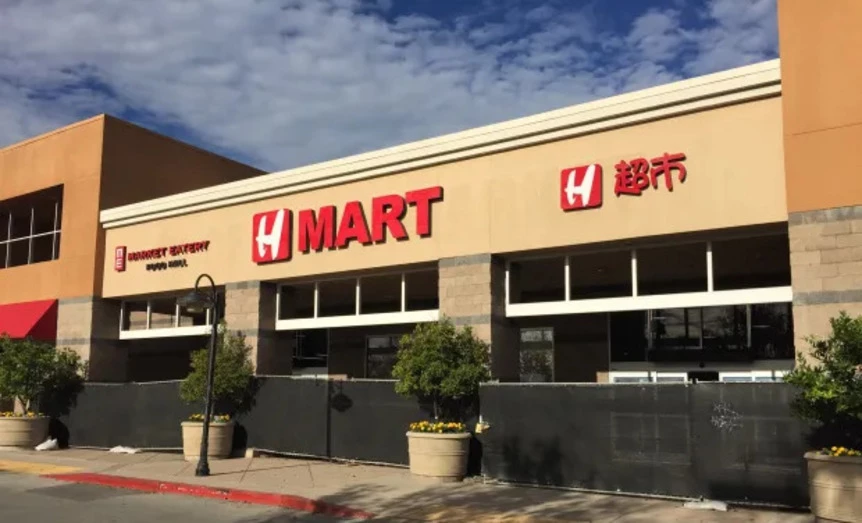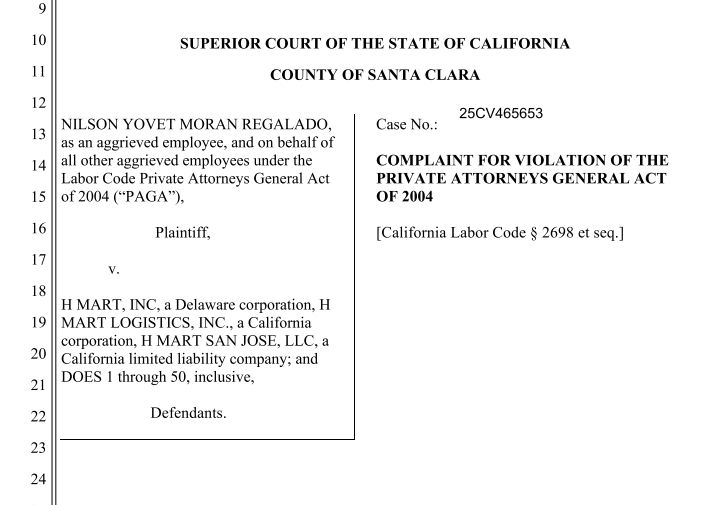https://knewsla.com/kcommunity/20250702339550/
[단독] 전국 최대 한인 마켓, 캘리포니아 PAGA 대표소송 피소 … 대규모 민사벌금 직면 파장
캘리포니아 19개 매장 노동자 전체에 영향, 전국 최대 한인 마켓의 노동법 위반 논란

미 전국에 매장을 둔 최대 한인 마켓 체인 H마트가 캘리포니아에서 노동법 위반 혐의로 노동법 위반 소송에 휘말렸다. 특히 이번 소송은 캘리포니아의 독특한 제도인 ‘민간 검찰법'(PAGA)에 따른 대표소송으로, 캘리포니아 내 H마트 매장 대부분의 직원들에게 적용될 가능성이 있어 상당한 파장이 예상된다.
전직 H마트 직원 닐슨 요벳 모란 레갈라도는 지난 5월 산타클라라 카운티 수피리어 법원에 피해 직원들을 대표해 H 마트 Inc., H 마트 로지스틱스 ics Inc., H 마트 산호세 LLC 등 3개 법인을 상대로 PAGA 소송을 제기했다. PAGA 소송은 지난 2004년 제정된 ‘캘리포니아 노동법 민간 검찰법'(PAGA)에 따른 대표소송이다.
이 소송은 H마트가 캘리포니아 내에서 체계적으로 임금 및 근로시간 관련 법규를 위반했다고 주장하며, 대규모 민사 벌금 회수를 목표로 하고 있어 소송 결과에 따라서는 H마트에 거액의 벌금이 부과될 수 있다.
소장에서 원고는 지난 2024년 10월 20일부터 2025년 1월 19일까지 캘리포니아 내 H마트 매장에서 시급 17.55달러를 받는 비면제(non-exempt) 요리사(Cook)로 근무했으며, 이 기간 중 다수의 노동법 위반을 겪었다고 주장하고 있다.
전직 직원 레갈라도는 H마트가 캘리포니아 매장들에서 공통된 정책과 관행을 통해 직원들의 법적 권리를 침해했다며 소장에서 자신과 직원들이 겪은 노동법 위반 혐의들을 지적했다.
 레갈라도는 소장에서 식사시간과 휴식시간을 제대로 제공받지 못했으며 초과근무 수당 및 최정임금도 제대로 받지 못했다고 주장했다.
레갈라도는 소장에서 식사시간과 휴식시간을 제대로 제공받지 못했으며 초과근무 수당 및 최정임금도 제대로 받지 못했다고 주장했다.
레갈라도가 소장에서 주장한 H 마트의 노동법 위반 혐의는 식사 시간 미제공(직원들이 식사 시간에도 근무하거나 대기 상태로 남아야 했으며, 식사 시간을 가지려면 허락을 받아야 했다고 주장.), 휴식 시간 미제공(인력 부족 등으로 인해 법적 휴식 시간이 제대로 보장되지 않았다고 주장), 회복 시간·식수 미제공(일부 근무 환경에서 직원들에게 회복 시간(cool-down period) 및 충분한 식수가 제공되지 않아 관련 법령을 위반했다는 주장), 초과 근무 수당 및 최저임금 미지급( 비번 시간 근무 및 식사·휴식 시간 중 근무에 대한 초과근무 수당 또는 최저임금 지급이 누락됐다는 주장) 등이다.
또, 레갈라도는 H 마트측이 임금 명세서 및 퇴직 시 임금 지급 의무를 위반했으며, 직장 폭력 예방 계획도 이행하지 않았다고 지적했다.
원고인 레갈라도는 지난 2025년 2월 27일 ‘캘리포니아 노동 및 인력 개발국'(LWDA)에 이 같은 위반 사실을 공식 통보했으며, 이후 65일 동안 LWDA가 별다른 조치를 취하지 않아 PAGA 대표 소송 요건을 충족했다고 밝혔다.
소장은 PAGA 위반에 따른 민사 벌금 회수를 목적으로 하며, 적용 범위는 소송 통지일 기준 1년 전부터 최종 판결 시점까지다. 소송 결과에 따라 민사 벌금의 상당 부분이 캘리포니아 주와 피해 직원들에게 분배될 수 있다.
현재 H마트는 캘리포니아에서 최소 19개 이상의 매장을 운영하고 있으며, 이번 소송 결과에 따라 이들 매장에 공통 적용된 정책으로 피해를 입은 직원들이 모두 영향을 받을 수 있다.
특히 PAGA 소송의 특성상, 이번 소송은 개인의 피해 보상 청구가 아닌 캘리포니아 노동법 위반에 따른 민사 벌금을 청구하는 대표 소송이어서 2024년 2월 이후 캘리포니아 내 H마트 19개 이상 매장에서 근무한 모든 비면제(non-exempt) 직원들이 해당 기간 동안 동일한 위반을 겪었다면 민사 벌금 회수 대상이 될 수 있다.
<김상목 기자>


